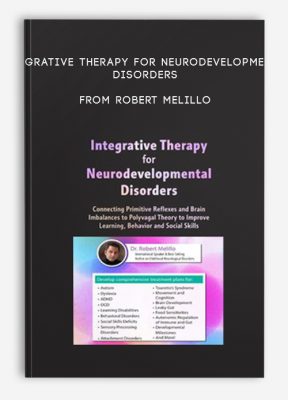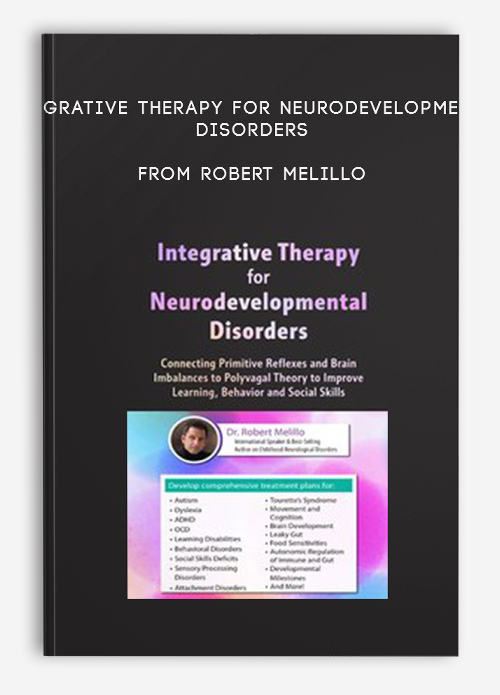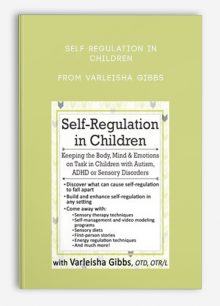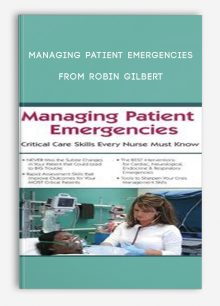Subtotal: $47.00
Integrative Therapy for Neurodevelopmental Disorders from Robert Melillo
$109.00 $32.00

Integrative Therapy for Neurodevelopmental Disorders Connecting Primitive Reflexes and Brain Imbalances to Polyvagal Theory to Improve Learning, Behavior and Social Skills from Robert Melillo
Faculty:Robert Melillo
Duration:6 Hours 37 Minutes | Format:Audio and Video
Archive : Integrative Therapy for Neurodevelopmental Disorders
Get Integrative Therapy for Neurodevelopmental Disorders on Salaedu.com
Outline:
DEVELOPMENTAL NEUROLOGY OVERVIEW
- Epidemiology of mental health, educational, and neurobehavioral disorders
- Movement and brain development
- Brain development through segregation, integration, and localization of networks
- Primitive and postural reflex development and retention, plus the relationship to brain development
- Brain asymmetry, development, function, and integration of the hemispheres, plus the relationship to learning disabilities, behavioral
- disorders and socialization issues
ASSESSING AND REMEDIATE RETAINED PRIMITIVE REFLEXES
- What are primitive reflexes? Why and how do they develop?
- Assess primitive reflexes in infants, children, and adults
- Symptoms associated with specific primitive reflex retention
- Asymmetry of primitive reflexes and the relationship to brain imbalances, ADHD, dyslexia
- HANDS-ON LAB: Remediation exercises for primitive reflexes
- CASE STUDY: Adult female with multiple retained primitive reflexes, history of dyslexia, depression, digestive issues, and syncope
PRACTICAL IMPORTANCE OF THE POLYVAGAL THEORY IN LIFE AND IN CLINICAL PRACTICE
- Polyvagal theory and evolution of the autonomic system
- Fear paralysis reflex, the Moro reflex, and both the parasympathetic and sympathetic nervous systems development
- Relate movement and primitive reflexes with Polyvagal Theory
- Autonomic and hemispheric regulation of immune system, gut function, and other issues
- Assess autonomic development, heart rate variability, and autonomic dysregulation
- Connect brainstem development, the development of the social engagement system, and attachment disorders
- HANDS-ON LAB: 35 ways to stimulate the Vagal system
- CASE STUDY: Child with ADHD, retained Moro reflex, and abnormal heart rate variability
- CASE STUDY: Patient with autonomic imbalance and autism
HEMISPHERIC DOMINANCE VS HEMISPHERIC WEAKNESS
- Right brain vs left brain functions
- Why and how the right and left brain become specialized
- How imbalances can develop
- How imbalance produces specific symptoms
- HANDS-ON LAB: Testing for brain imbalances
- Cognitive style profile
- Hemispheric checklist
- Postural hemispheric exam
- Cranial nerve exam
- Develop specialized hemispheric-based treatment to restore balance
- CASE STUDY: Patient with dyslexia, learning disabilities and retained primitive reflexes
ATTACHMENT, POLYVAGAL SYSTEM, AND HEMISPHERIC IMBALANCE
- Understanding attachment and behavior
- Relate attachment with movement and discover the subconscious way we form and maintain relationships, and how this can affect us our whole life
- How the brain hemispheres contribute to attachment
- Functional neurology of human behavior, relationships and emotions
- HANDS-ON LAB: Use the adult attachment inventory as a diagnostic tool
- HANDS-ON LAB: Target functional neurology networks diagnostically and therapeutically
- CASE STUDY: Patient with reactive attachment disorder and ADHD
Get Integrative Therapy for Neurodevelopmental Disorders on Salaedu.com
Description:
Motor, sensory, behavioral, academic, digestive, immune and autonomic dysregulation issues are all seen in various combinations and degrees in neurobehavioral disorders such as ADHD, Autism, learning disabilities, behavioral problems, and social skills deficits.
But, why? What is the link? Most experts believe that these disorders are connected to one another. How? In this recording, Dr. Melillo will answer these questions in the most practical way.
Based on 20 years of clinical experience and cutting-edge brain science, Dr. Melillo will teach you new and innovative therapy techniques that connect motor development to cognitive development, and examine the relationship to early milestones and retained primitive reflexes. You will learn to tie all of this together with the Polyvagal Theory, brain hemisphericity and a holistic understanding of how the brain and the hemispheres regulate everything. You will learn techniques and tools that translate into clinical success no matter what the condition or severity.
With the rise of developmental neurobehavioral disorders and the overwhelming wide spectrum of related symptoms, understanding the root cause of neurobehavioral and learning disorders is essential to successful treatment.
From this recording, you’ll learn:
- Techniques to identify and remediate Polyvagal issues, retained primitive reflexes and a wide variety of behavioral, learning and social issues
- Strategies to quickly and effectively inhibit primitive reflexes and promote the development of postural reflexes
- Tools to asses and promote balance in postural, oculomotor and vestibular systems
- Assessments for motor, sensory, academic, cognitive and behavioral skills
- Sensory, motor, cognitive and behavioral techniques to promote brain integration
- Nutritional and simple dietary assessments and interventions
1 review for Integrative Therapy for Neurodevelopmental Disorders from Robert Melillo
Add a review Cancel reply
Related products
HEALTH - FITNESS - LIFESTYLE - MEDICAL
HEALTH - FITNESS - LIFESTYLE - MEDICAL
HEALTH - FITNESS - LIFESTYLE - MEDICAL
HEALTH - FITNESS - LIFESTYLE - MEDICAL
HEALTH - FITNESS - LIFESTYLE - MEDICAL
HEALTH - FITNESS - LIFESTYLE - MEDICAL
Complete Certified Professional Coach Online Course from Berry Fowler

 Fitness Mentors – Audio Lectures, Practice Tests and Study Guide for the NASM CPT Ex
Fitness Mentors – Audio Lectures, Practice Tests and Study Guide for the NASM CPT Ex 








king –
“Excellent course! Keep giving seminars on this topic!”